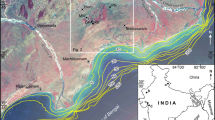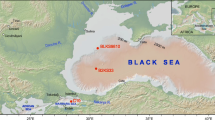Abstract
Environmental history of the northern continental shelf of the South China Sea during the last 280 ka BP, e.g. Marine Isotope Stages 1–8 (MIS 1–8) was reconstructed based on pollen record from the top 225m of ODP 1144 Site. During the interglacial periods, pollen assemblages are predominated by pine similar to those of the present day indicating that the environment of the interglacial periods was more or less close to that of today. Nevertheless, those from glacial periods are characterized by a large amount of herbaceous pollen, e.g.Artemisia, Gramineae, Cyperaceae, etc. inferring that grassland covered the merged continental shelf when the sea level lowered and the continental shelf was exposed. The exposed areas of the shelf were insignificant before MIS 5, but enlarged since MIS 4 and reached its maximum during MIS 2 according to ratios of pollen percentages between pine and herbs. The history of different exposure of the shelf can be compared with transgression records of the coastal areas of China and might result from neotectonic movement of Chinese continent. Some changes also took place in the components of grassland growing on the shelf during glaciations. Gramineae is the main element at MIS 8. ThenArtemisia increased upwards the profile and at last became the main component at the Last Glacial Maximum (MIS 2). Such changes in vegetation might be in response to cooler and drier climate.
Similar content being viewed by others
References
Wang, P., West Pacific in glacial cycles: Seasonality in marginal sea and variability of Warm Pool, Science in China, Ser. D, 1998, 41 (1): 35.
Jian, Z., Li, B., Pflaumann, U. et al., Late Holocene cooling event in the West Pacific, Science in China, Ser. D, 1996, 39(5): 543.
Jian, Z., Chen, M., Lin, H. et al., Stepwise paleoceanographic changes during the last deglaciation in the southern South China Sea: Records of stable isotope and microfossils, Science in China, Ser. D, 1998, 41(2): 187.
Sun, X., Li, X., A pollen record of the last 37 ka in deep sea core 17940 from the northern slope of the South China Sea, Marine Geology, 1999, 156: 224–227.
Sun, X., Li, X., Luo, Y. et al., The vegetation and climate at the last glaciation on the emerged continental shelf of the South China Sea, Palaeogeogr. Palaeoclimatol. Palaeoecol., 2000, 160: 301–316.
Department of Tectonics, Institute of Oceanography, Chinese Academy of Sciences, Geological Tectonics of the South China Sea and Spreading of the Continental Margin (in Chinese), Bei**g: Science Press, 1988, 339–379.
Zhao Huanting, Zhang Qiaomin, Song Chao**g et al., Geomorphology and environment of the South China Sea islands (in Chinese), Bei**g: Science Press, 1999, 1–528.
Wang, P., Prell, W. L., Blum, P. et al., Proc. ODP, Init. Repts. 184, College Station TX (Ocean Drilling Program), 2000, 1–77.
Florin, R., The distribution of conifer and taxad genera in time and space, Acta Horti Bergiani., 1963, 20 (4): 121–312.
Cooling, E. N. G.,Pinus Mercusii Fast Growing Timber Tree of Lowland Tropics, Oxford: Dep. Forestry, Oxford, 1968.
Sun, X., Li, X., Beug, H. J., Pollen distribution in hemipelagic surface sediments of the South China Sea and its relation to modern vegetation distribution, Mar. Geol., 1999, 156: 211–226.
Sun **angjun, Song Changqing, Wang Fengyu, Pollen-climate response surface of selected taxa from northern China, Science in China, Ser. D, 1996, 39 (5): 486–493.
Gao Qian, Zhang Guangqie, Bryophytes of Northeast China (in Chinese), Bei**g: Science Press, 1981.
Zheng, Z., Lei, Z. Q., A 40000 years record of vegetation and climate change from a volcanic basin, Leizhou Peninsula, Southern China, Palaeogeogr. Palaeoclimatol. Palaeoecol., 1999, 145: 339–362.
Lie Zuoqi, Zheng Zhuo, Late Quaternary sporo-pollen assemblage and palaeoenvironment change of Huangmao Sea (Pearl River Mouth), Tropical Oceanography (in Chinese with English abstract), 1990, 9 (4): 24–28.
Zheng Zhuo, Holocene pollen analysis and environmental research in the Chaoshan Plain, Tropical Oceanography (in Chinese with English abstract), 1990, 9 (2): 31–38.
Wang Pinxian, The South Sea During the Last 150000 Years (in Chinese), Shanghai: Tongji University Press, 1995, 1–184.
Chen **nshu, Bao Liyan, Chen Junren et al., Discovery of lowest sea level in Late Quaternary at the continental shelf off Pearl River Mouth, Tropical Oceanography (in Chinese with English abstract), 1990, 9 (4): 73–77.
Travers, A., Production, Dispersal, and Sedimentation of Spores/Pollen, Palyopalenology-Charpter 17 (ed. Travers, A.), Boston: Unwin Hyman, 1988, 375.
Wang Pinxian, **a Lunyu, Zheng Fan, A Preliminary Note on the Late Quaternary Microfauna of the Beibu Gulf and Its Bearing on Sea-Level Changes, Marine Miropaleontology (ed. Wang Pinxian), Bei**g: China Ocean Press, 1980, 140–145.
Min Qiubao, Zhao Quanhong, Wang Pinxian, Paleoceanography of the outer shelf, northern South China Sea, in A preliminary study: Contributions to Late Quaternary paleoceanography of the South China Sea (in Chinese with English abstract) (eds. Ye Zhizheng, Wang Pinxian), Qingdao: Qingdao Ocean University Press, 1992, 1–324.
Li Jijun, Fang Saomin, Studies on the uplift and environmental changes of the Qinghai-**zang Plateau, Chinese Science Bulletin (in Chinese), 1996, 41: 316–322.
Li, J., The environmental effects of the uplift of the Qinghai-**zang Plateau, Quaternary Science Review, 1991, 10: 479–483.
Wu **hao, Jiang Fuzhu, Wang Sumin et al. On the problem of the Yellow River cutting the sanmen Gorge and flowing eastward into the sea, Quaternary Sciences (in Chinese), 1998, 2: 188.
Chappell, J., Shackledon, N. J., Oxygen isotopes and sea level, Nature, 1986, 324 (13): 137–140.
Author information
Authors and Affiliations
Corresponding author
Rights and permissions
About this article
Cite this article
Sun, X., Luo, Y. Pollen record of the last 280 ka from deep sea sediments of the northern South China Sea. Sci. China Ser. D-Earth Sci. 44, 879–888 (2001). https://doi.org/10.1007/BF02907079
Received:
Issue Date:
DOI: https://doi.org/10.1007/BF02907079




